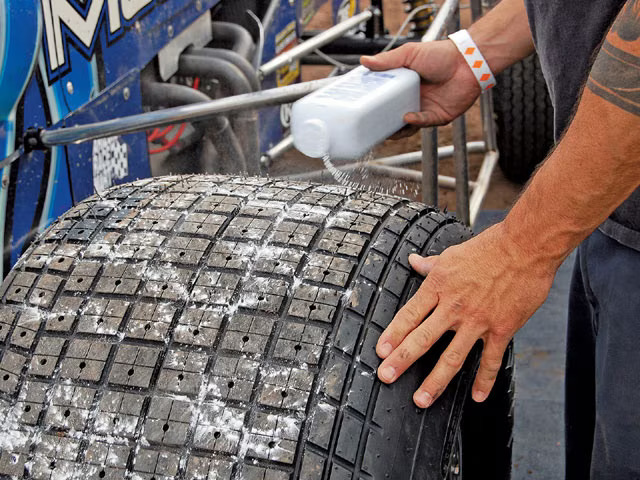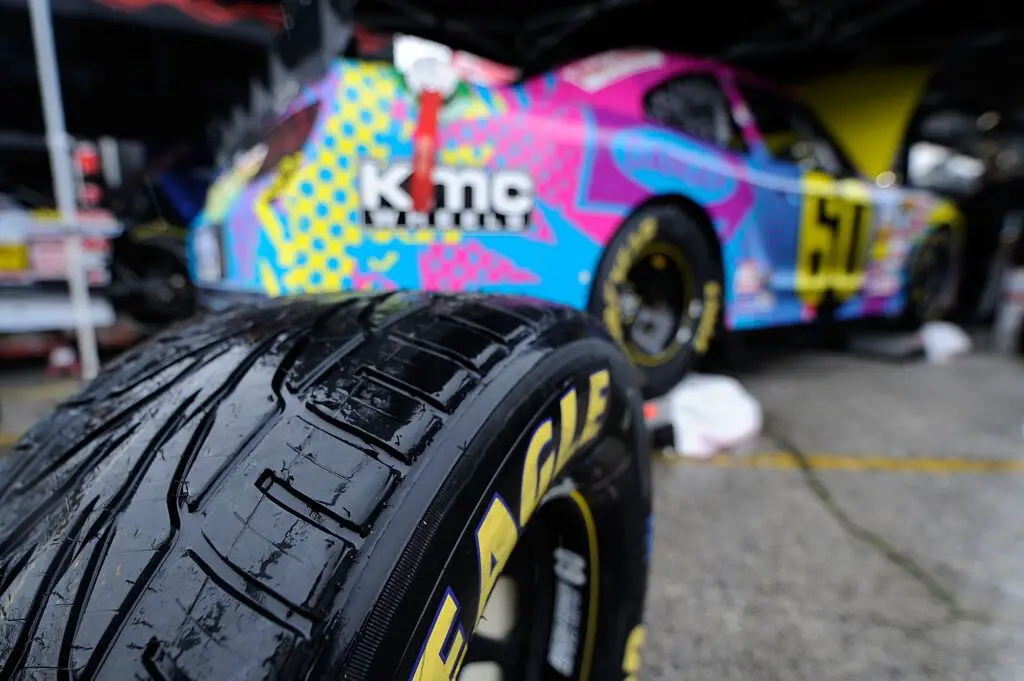In the world of racing, tire doping is a really popular term. It’s used by many motor enthusiasts, professional drivers, bike riders, etc. It can provide the tires with a lot of advantages!
Additionally, there’s a dilemma for tire doping to be illegal. Many racers and enthusiasts still debate the laws of tire doping. Don’t stress though, I’ve answered everything here.
So, what is tire doping?
Tire doping is the method of improving the grip, control, and versatility of tires by using chemicals/gases and grooving the tires. Tire doping has many pros and cons. Also, it’s considered to be illegal in racing platforms, whether it be flat track or tarmac.
This is just the summed-up version of the entire article. Read till the end to know all the critical details!
What is Tire Doping?
Tire doping is the technique of altering the tires of a racing vehicle to get more traction on the tires. In turn, it increases the forward bite of vehicles and vehicle speed while decreasing lap times.
There are a few misconceptions regarding tire prepping and tire doping. Tire prepping is the process of preparing a tire before a race. This does not involve any chemicals and gasses. For example, prepping the tires of a go-kart.
On the contrary, tire doping is the process of enhancing the characteristics of the tire by using chemicals. Better cold grip, heat management of the tire, and traction are the primary goals of tire doping.

The information regarding methods of tire doping will help you know more about it. The next section is all about tire doping methods; check it out!
Methods of Tire Doping
Tire doping has more than one method. Each method has different outcomes and sustainability. Below, I’ve elaborated on every method of tire doping, give it a read.
Method 1: Using Chemicals
This is the most common method of tire doping out there. Various chemicals are used to soak the tires and give the tires the upper hand in performance. Different chemicals are used for softening and hardening the tires before a race.
To soften up tires, you can use chemicals like acetone, toluene, xylene, kerosene, etc. Powders like sulfur, salt, carbon black, and silicon dioxide are used to harden the tires.
| Tire Softeners | Tire Hardeners |
| Acetone | Silicon Dioxide |
| Toluene | Sulfur |
| Xylene | Carbon Black, Salt |
| Kerosene | – |
If you’re looking to harden the tires, you can use chemical powders. Covering the surface with any of the powders mentioned above will do the trick. The powders will absorb the moisture from the tire, vulcanizing it.

On the other hand, to soften the tires-
- First, get a few rugs and the chemical of your choice.
- Then, dip the rugs in the chemical and soak the rugs completely.
- Next, cover the tire you want to soften with the rugs. Make sure the rugs reach the entire surface of the tire.
- Finally, use a tire wrap to lock the rugs in place. Leave the wrap overnight so that the tire seeps in all the chemicals.
You can also make tire softeners at home and use them. Note that, don’t leave the plastic wrap for too long. The plastic may get stuck with the tires due to chemical reactions.
Method 2: Using Gases
Generally, tires are filled with compressed air. This air consists of 78 percent nitrogen, 21 percent oxygen, and 1 percent of other gases.
But, filling the tire with compressed nitrogen can dope the tire. Compressed nitrogen is lighter than compressed air.
Ultimately, this will make the racing vehicle lighter significantly. As a result, the vehicles can accelerate quicker and achieve greater speeds. The air sealing of the vehicle wheel will also improve as pure nitrogen is free of moisture.
To fill your tires up with nitrogen, follow the steps below-
- First, let out the existing air in your tire by purging it.
- Then, use a pressure gauge to measure the air pressure inside the tire. The pressure should be about 3 PSI.
- Finally, refill the tire with compressed nitrogen. Remember, the purer the nitrogen, the better.
Method 3: Grooving the Tires
Grooving out racing tires is a great way to provide the tires with an extra grip. The cleaner the pores of the tires are, the better the traction and control.
To regroove the tires-
- Start by cleaning the tire you want to regroove. Get rid of any dust and debris on the tire, and wash the tire if needed.
- Then, grab a tire grooving tool and heat it to your desired temperature.
- Next, start regrooving the tire. Regroove the tire along the existing grooves of the tire. Make the grooves a bit deeper so that the tire can grip better.
Don’t get the grooves too deep, the tires might get punctured that way.
Finally, as a safety step, apply some tire sealant on the tire. You can either spray the sealant or apply it with a brush, it’s up to you. Make sure the sealant reaches the entire surface of the tire.

Pros and Cons of Tire Doping
Now that we know about tire doping, let’s know the effects. Tire doping comes with both pros and cons.
Advantages:
Here are some advantages of tire doping-
- Better control and traction: Modified tires will have a better grip and control on the race tracks.
- More speed: The forward bite of the tires will increase the speed of the racing vehicle. This can be advantageous when counting lap times.
- Lasts longer: Doped tires tend to last longer. You can use a doped racing tire for much longer than a regular racing tire.
Disadvantages:
Here are a few disadvantages of tire doping-
- Promotes unfair racing: As stated before, doped tires directly hinder the equal racing ground for the racers.
- Tire quality decreases: Tire doping leads to altering the natural state of racing tires. Although this enhancement gives out a few advantages, it wears out tires super fast.
- Safety concerns: Doping the tire can introduce several risk factors, especially for racers who are new to doped tires. Since it has different characteristics, not adapting to it at high speeds may be dangerous!
Not to mention tire doping is costing the racing event promoters more money. The promoters are forced to get more expensive kits to test out the tires to detect doping.
However, many people argue that tire doping is not legal. But is that statement true? I’ve answered this in the next segment, keep reading!
Is Tire Doping Illegal?
Contrary to popular belief, yes, tire doping is illegal. Tire doping is illegal on flat tracks and tarmac is banned. Many racers got accused and disqualified for tire doping. For example, Indian Wrecking Crew rider Jared Mees was disqualified for tire doping at the Dixie Speedway event. A 1-year probation was also charged.
Tire doping is banned because it is considered to be ‘cheating’. Similarly, horse doping and human doping are also banned.
It is possible to seek out and diagnose doped tires before a race. Chemical tests on tires can prove if a tire is doped or not. If any chemical is found other than the tire material’s chemicals, it’s considered a doped tire.
However, as technology is advancing day by day, doping techniques are also evolving. Now there are a few “untraceable” tire doping techniques out there.
Tire doping promotes unfair play. This gives out partial advantages to the tire-doped vehicles and increases the odds of them winning the race.
For instance, if different go-karts were using different roller chains, it would be pretty unfair. There are many differences between roller chains of different sizes. For example, the differences between 40 vs 428 chains are huge!
Frequently Asked Questions (FAQs):
Which tires wear faster?
The tires in the front wear faster compared to the tires in the back. In comparison, the front tires wear out 2.5 times faster than the rear tires. The reason behind this is, the front tires transmit the movements of the steering wheel. On the other hand, the rear tires stay stationary most of the time.
What damages tires the most?
Any kind of cuts, impacts, holes or punctures, cracks, etc damages tires the most. The damage might seem minimum initially. But, the quality of tire rubber will start to deteriorate with time, eventually making it unusable.
Is tire spray bad for tires?
Yes, tire spray is bad for tires. It messes with the natural condition of a tire by overworking the surface of the tire. As a result, the tire might have cracks on it due to being dry. In the worst-case scenario, the tire can pop in the middle of driving, which can cause road hazards.
The Final Words
That’s everything you need to know about tire doping. Hopefully, now you know the rules, regulations, and how-tos regarding doping the tires!
The best option is to avoid tire doping. That way, cheating won’t be promoted. Besides, prepping the tires well before a race should be adequate for good performance!
Best of luck.